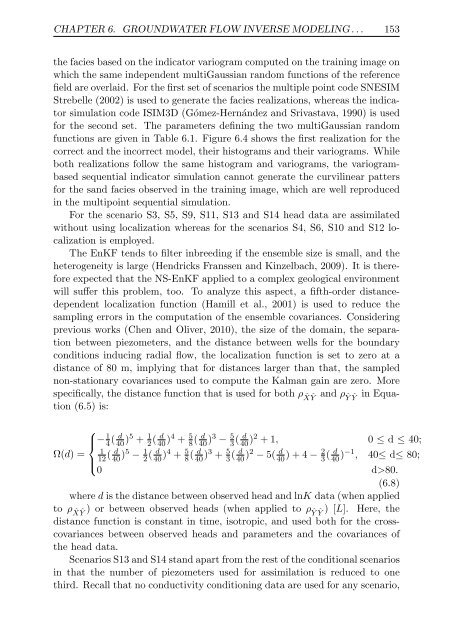Upscaling and Inverse Modeling of Groundwater Flow and Mass ...
Upscaling and Inverse Modeling of Groundwater Flow and Mass ...
Upscaling and Inverse Modeling of Groundwater Flow and Mass ...
Create successful ePaper yourself
Turn your PDF publications into a flip-book with our unique Google optimized e-Paper software.
CHAPTER 6. GROUNDWATER FLOW INVERSE MODELING . . . 153<br />
the facies based on the indicator variogram computed on the training image on<br />
which the same independent multiGaussian r<strong>and</strong>om functions <strong>of</strong> the reference<br />
field are overlaid. For the first set <strong>of</strong> scenarios the multiple point code SNESIM<br />
Strebelle (2002) is used to generate the facies realizations, whereas the indicator<br />
simulation code ISIM3D (Gómez-Hernández <strong>and</strong> Srivastava, 1990) is used<br />
for the second set. The parameters defining the two multiGaussian r<strong>and</strong>om<br />
functions are given in Table 6.1. Figure 6.4 shows the first realization for the<br />
correct <strong>and</strong> the incorrect model, their histograms <strong>and</strong> their variograms. While<br />
both realizations follow the same histogram <strong>and</strong> variograms, the variogrambased<br />
sequential indicator simulation cannot generate the curvilinear patters<br />
for the s<strong>and</strong> facies observed in the training image, which are well reproduced<br />
in the multipoint sequential simulation.<br />
For the scenario S3, S5, S9, S11, S13 <strong>and</strong> S14 head data are assimilated<br />
without using localization whereas for the scenarios S4, S6, S10 <strong>and</strong> S12 localization<br />
is employed.<br />
The EnKF tends to filter inbreeding if the ensemble size is small, <strong>and</strong> the<br />
heterogeneity is large (Hendricks Franssen <strong>and</strong> Kinzelbach, 2009). It is therefore<br />
expected that the NS-EnKF applied to a complex geological environment<br />
will suffer this problem, too. To analyze this aspect, a fifth-order distancedependent<br />
localization function (Hamill et al., 2001) is used to reduce the<br />
sampling errors in the computation <strong>of</strong> the ensemble covariances. Considering<br />
previous works (Chen <strong>and</strong> Oliver, 2010), the size <strong>of</strong> the domain, the separation<br />
between piezometers, <strong>and</strong> the distance between wells for the boundary<br />
conditions inducing radial flow, the localization function is set to zero at a<br />
distance <strong>of</strong> 80 m, implying that for distances larger than that, the sampled<br />
non-stationary covariances used to compute the Kalman gain are zero. More<br />
specifically, the distance function that is used for both ρ ˆ X ˆ Y <strong>and</strong> ρ ˆ Y ˆ Y in Equation<br />
(6.5) is:<br />
⎧<br />
⎪⎨ −<br />
Ω(d) =<br />
⎪⎩<br />
1 d<br />
4 (<br />
1 d<br />
12 (<br />
40 )5 + 1 d<br />
2 ( 40 )4 + 5 d<br />
8 ( 40 )3 − 5 d<br />
3 ( 40 )2 + 1, 0 ≤ d ≤ 40;<br />
40 )5 − 1 d<br />
2 ( 40 )4 + 5 d<br />
8 ( 40 )3 + 5 d<br />
3 ( 40 )2 − 5( d<br />
2 d<br />
40 ) + 4 − 3 ( 40 )−1 , 40≤ d≤ 80;<br />
0 d>80.<br />
(6.8)<br />
where d is the distance between observed head <strong>and</strong> lnK data (when applied<br />
to ρXˆ Y ˆ ) or between observed heads (when applied to ρYˆ Y ˆ ) [L]. Here, the<br />
distance function is constant in time, isotropic, <strong>and</strong> used both for the crosscovariances<br />
between observed heads <strong>and</strong> parameters <strong>and</strong> the covariances <strong>of</strong><br />
the head data.<br />
Scenarios S13 <strong>and</strong> S14 st<strong>and</strong> apart from the rest <strong>of</strong> the conditional scenarios<br />
in that the number <strong>of</strong> piezometers used for assimilation is reduced to one<br />
third. Recall that no conductivity conditioning data are used for any scenario,


